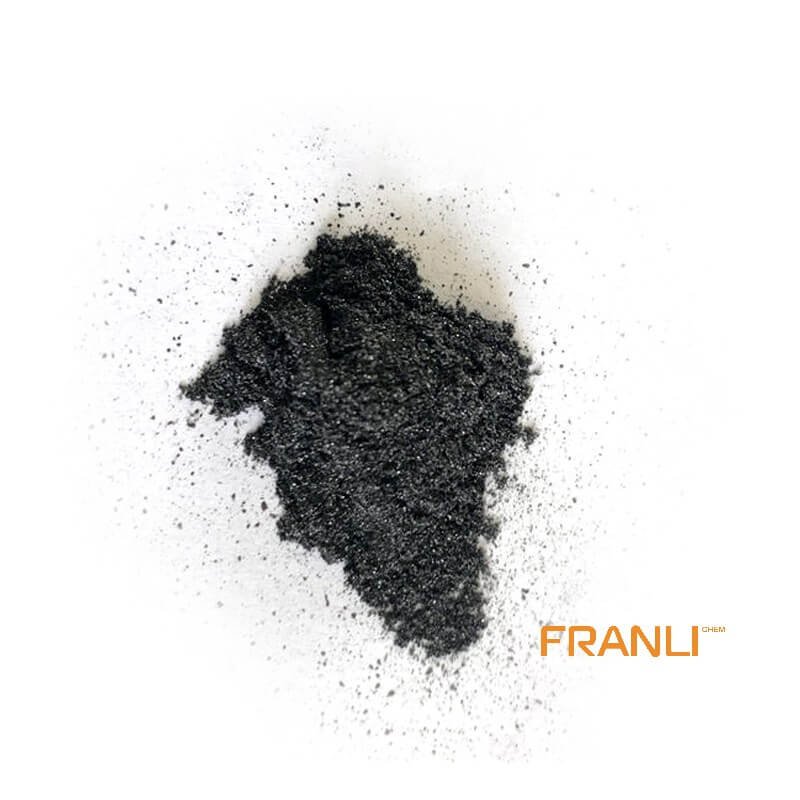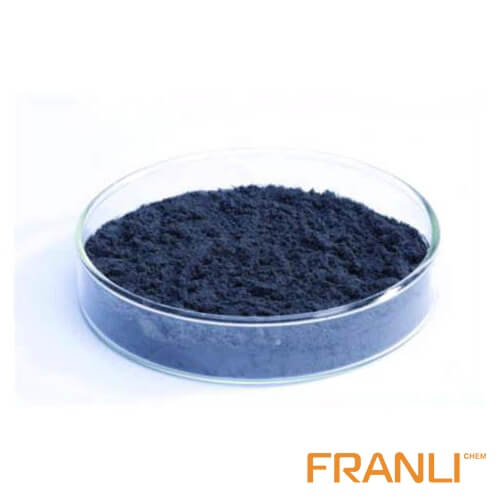


Expandable Graphite
Size
0.50mm or 0.106mm, etc
Package
25 kg small bags into ton bags
Origin
China
Features
Preservative/Electrical and thermal conductivity, etc.
Application
Fireproof sealing element, flame retardant, refractory brick, etc.
Expandable graphite crystal is a typical layered carbon material. Other heterogeneous particles such as atoms, molecules, ions, and even atomic clusters are inserted into the interlayer of crystalline graphite by physical or chemical methods to form a new layered compound, which is called graphite interlayer compound, namely expandable graphite.
Request a quote
Expandable graphite is a worm-like carbon material formed hundreds of times expansion of expandable graphite after instantaneous high-temperature treatment. It is non-toxic and pollution-free. It is an environment-friendly material. In addition to the high and low-temperature resistance, radiation resistance, corrosion resistance, electrical conductivity, and thermal conductivity of natural graphite. It also has excellent properties such as flexibility, compression, plasticity, good self-lubrication, shock resistance, aging resistance, and distortion resistance.

Preparation method of expandable graphite
There are many preparation methods of expandable graphite, but the main preparation methods are an electrochemical method, melting method, explosion method, and chemical oxidation method. This paper mainly introduces the preparation of expandable graphite by the chemical oxidation method. In recent years, a large number of research work at home and abroad on the preparation of expandable graphite by chemical oxidation has focused on the following aspects:
(1) Expandable graphite with low sulfur or without harmful sulfur to reduce the emission of harmful sulfur substances in the prepared expandable graphite. Fuweina et al. Prepared sulfur-free expandable graphite with an expansion multiple of 317 ml · g-1 from graphite, concentrated nitric acid, 30% H2O2, and acetic anhydride, and used it to adsorb oil substances. Li Yufeng and others prepared sulfur-free expandable graphite with an expansion ratio of 300 ml · g-1 with fine flake graphite under the action of mixed acid of nitric acid and phosphoric acid and KMnO4. Yao Yongping used graphite, nitric acid, and phosphoric acid as raw materials to prepare sulfur-free expandable graphite with an expansion multiple of 312 ml · g-1.
(2) In some special fields, the expansion multiple can reach more than 200 times, but the expandable graphite with relatively low temperature is also a hot research direction. Wang Ling et al. Prepared low-temperature expandable graphite by reacting HNO3, hbro3, and KMnO4 for 40 min at 25 ℃. The expandable graphite obtained by this method can expand at 130 ℃, and its expansion volume can reach 350 ml · g-1 at 600 ℃.
(3) In order to improve the oxidation resistance of graphite products at high temperatures, the developed high-temperature oxidation-resistant expandable graphite is also a research hotspot. Jin Liguo and others prepared sulfur-free antioxidant expandable graphite with phosphate-based pregnant, which can also maintain high antioxidant capacity under oxygen enrichment at 650 ℃. Liu Lilai and others first used natural flake graphite, nitric acid, potassium permanganate, and hydrogen peroxide as raw materials to prepare sulfur-free low ash expandable graphite. Then potassium dihydrogen phosphate saturated solution, boric acid saturated solution, phosphoric acid, and the mixture of these three solutions are used as antioxidants for secondary impregnation intercalation to prepare sulfur-free and high antioxidant expandable graphite. The maximum expansion multiple can reach 280 ml · g-1.
(4) With the enhancement of environmental awareness, how to reduce the pollutants produced in the preparation of expandable graphite has become an important content of the research on the preparation of expandable graphite by chemical oxidation. At present, heavy metal ions are the main pollution sources in the preparation of expandable graphite. Chen Xiaowei of Qingdao University used ammonium nitrate and concentrated sulfuric acid as oxidants and twice feeding method to prepare a low pollution expandable graphite. The maximum expansion volume of the expandable graphite can reach 400 ml · g-1, and no heavy metal ions were introduced in the preparation process, so as to eliminate the possibility of pollution of heavy metal ions.
Application of expandable graphite
As a functional material, expandable graphite has been studied and widely used in various fields because of its excellent characteristics such as high thermal conductivity, strong adsorption capacity, porous and lightweight. The preparation, research, and application of some composites with expandable graphite are briefly introduced below.
Wang Fanfan et al. Used iron nitrate and cobalt nitrate as main raw materials, prepared co2feo4 nanomagnetic particles by chemical coprecipitation method, and then compounded them with expandable graphite to prepare magnetic expandable graphite with different co2feo4 loading. The results show that the magnetic expandable graphite composite reaches saturated adsorption after the 90s; When the co2feo4 load is 35%, the magnetic recovery is 99.2%.
Yang Yushan et al. Prepared an electromagnetic shielding composite with expandable graphite and metal mesh as electromagnetic shielding basic materials and ABS resin by blending, extrusion, and hot pressing. The results show that the electromagnetic shielding efficiency of expandable graphite / ABS electromagnetic shielding composite increases with the increase of expandable graphite content and composite thickness, The expandable graphite after ultrasonic treatment can improve the shielding effect of the composite.

Under the condition of ultrasonic oscillation, Guo Chunyu mixed expandable graphite with coconut shell-based activated carbon and activated mesophase carbon microspheres to prepare expandable graphite / activated carbon composites and assembled them into aqueous electric double-layer capacitors. The results show that the specific capacitance of the electric double layer can reach 359 f · g-1. Under the condition of high current discharge, the decrease rate of specific capacitance is only 6.6%.
Zhang qinzhen used the high adsorption and high thermal conductivity of expandable graphite and paraffin to prepare medium and low-temperature phase change heat storage materials with different ratios. The thermophysical parameters of each group of composite phase change heat storage materials were tested by DSC. The results show that when the content of expandable graphite is less than 5%, it has little effect on the phase transition point and enthalpy change of paraffin, and has strong heat storage capacity and high heat flux density.
Xing Xiaoling et al. Prepared nano metal cobalt / expandable Graphite Nanocomposites by impregnation, drying, and hydrogen reduction. It is found that the metal cobalt particles in the composites prepared by this method are evenly dispersed on the nano level of expandable graphite, and when the content of metal cobalt is 10% ~ 40%, the metal cobalt has high permeability, resulting in good low-frequency electromagnetic shielding effect.
Liu Dewei and others first treated expandable graphite by ultrasound, and then prepared nitrile rubber / expandable Graphite Nanocomposites by melt intercalation method. The results show that the expandable graphite in the composites prepared by this method is evenly dispersed in the rubber matrix with nano size. Moreover, the tensile strength, surface conductivity, and volume conductivity of the composites are much stronger than those without expandable graphite.
Ying Zongrong and others prepared plasticized polystyrene / expandable graphite conductive composites by direct melt mixing method. The results show that this method can indeed prepare conductive composites with excellent conductivity, and the amount of plasticizer and expandable graphite have a great influence on the conductivity of the composites. In addition, they can also affect the mechanical properties of the composites.
Zhang Qian et al. Studied and prepared carbon nanotube / expandable graphite composites to interfere with 8 mm waves. The results show that after high-temperature heat treatment, carbon nanotubes are distributed in the surface and interlayer pores of expandable graphite in the form of the film; Moreover, with the addition of carbon nanotubes, not only the surface conductivity of the material is enhanced, but also the attenuation ability of electromagnetic wave is enhanced, but the diamagnetic properties of expandable graphite are not changed. When the mass addition of carbon nanotubes is 29%, the attenuation ability is the strongest. It is obviously better than pure expandable graphite.
Liu Lanxiang and others used expandable graphite as a carrier to evenly disperse magnetic nano nickel-iron alloy on the surface of expandable graphite, so as to prepare nano nickel-iron alloy / expandable graphite composite. The results show that the content of nanometals in the composites is high and the crystal form is good. Moreover, the composites have a good shielding ability to high-frequency electromagnetic waves. Especially when the mass ratio of raw materials in the composite is Ni: Fe: eg = 27:3:70, the electromagnetic wave shielding effect in the frequency range of 300 kHz ~ 1.5 GHz can reach 66 ~ 110dB, and its electromagnetic shielding efficiency are very excellent.
Wan Chuanyun and others synthesized manganese dioxide / expandable Graphite Composites by redox method and applied them to capacitors. In the composites synthesized by this method, manganese dioxide exists in amorphous form, and through the study of electrochemical properties, it is found that the electrochemical behavior of the prepared composites is different in different kinds of cationic electrolyte systems. For example, in the sodium-ion electrolyte, the composite electrode has high capacitance. However, in the potassium ion electrolyte system, the current response of the composite electrode is very fast.
Kangding et al. Prepared polyethylene glycol / expandable Graphite Composites by vacuum infiltration method. It is found that polyethylene glycol is well adsorbed in the loose and porous structure of expandable graphite, and the measured phase change temperature and phase change enthalpy of the material are higher than those calculated theoretically, which shows that the addition of expandable graphite effectively improves the phase change energy storage efficiency of polyethylene glycol.
From the research of the above researchers, we can find that the expandable graphite composite has applications in adsorption, energy storage, catalyst support, and so on. On the one hand, the addition of expandable graphite has greatly improved the properties of the material, on the other hand, it is due to the rich pore structure of expandable graphite. Therefore, expandable graphite as new functional material has attracted the attention of researchers.
Expectation
In order to accelerate the transformation and development of coal cities and vigorously develop advanced manufacturing industry, the mineral intensive processing industry has been listed as the key development direction and key projects, of which graphite is listed as the key development direction. With the continuous development of graphite industry technology and the maturity of downstream applications, expandable graphite, as an important downstream product, has a good development momentum in the fields of compliance materials, anti-corrosion coatings, display industry, and so on. In addition, expandable graphite plays an important role in the graphite sealing industry, and its potential economic value is considerable.



